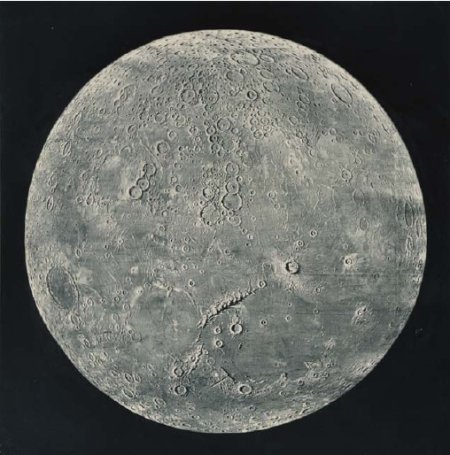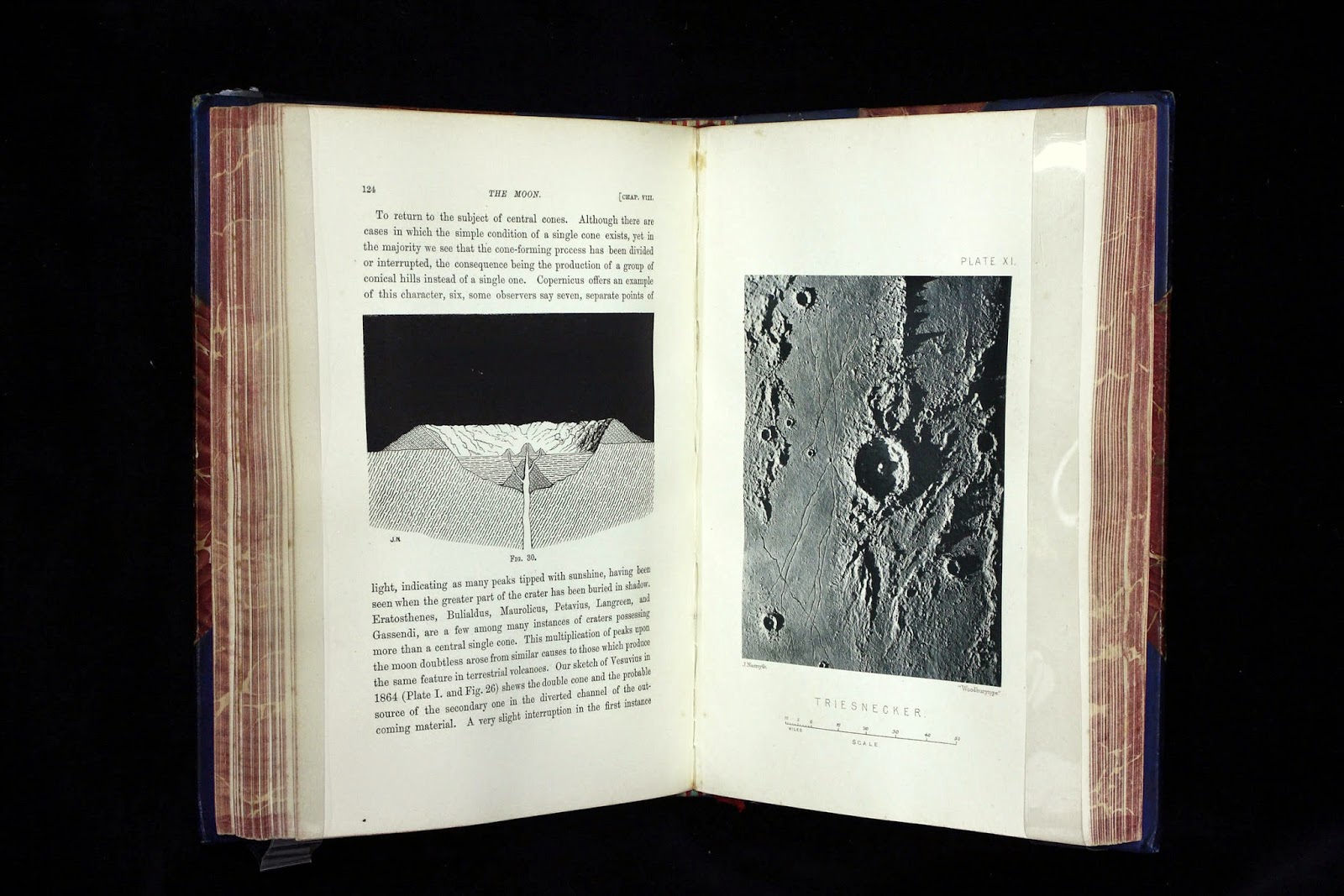
INSIDE COVER: Stella Halkyard Pictures from a Library 6: James Nasmyth The Poetics of Space: James Nasmyth and The Moon Considered...
Woodbury-type photograph by James Nasmyth from The Moon Considered as a Planet, a World, and a Satellite by James Nasmyth and James Carpenter. Reproduced by courtesy of the University Librarian and Director, The John Rylands Library, The University of Manchester.
The 'voice' in one of Emily Dickinson's poems urges its reader to 'Tell all the Truth but tell it slant - ': 'Success in Circuit lies'. It would have been impossible for the inventor James Nasmyth to have known Dickinson's verse, bound as it was in a tiny handmade fascicle hidden in a trunk at the end of her bed, but the book he produced with James Carpenter in 1874, The Moon Considered as a Planet, a World, and a Satellite, seems to have been touched by it.
Born into an artistic family in Edinburgh in 1808 and exhibiting considerable gifts as a draughtsman, Nasmyth became an engineering prodigy. Trained in London and Edinburgh, he came to Manchester, which was rapidly developing into a centre of engineering, in 1834. In 1839, at the Bridgewater Foundry in Patricroft, he invented the steam hammer and produced 'superlative machines of all sorts'. At the age of 48 he was able to retire and spend his fortune, time and talents pursuing his interests in astronomy and the new medium of photography.
The Moon Considered... provided the opportunity to indulge both passions at once. This odyssey in space delineates in minute, yet astronomical, detail the topography and geology of the moon as studied over a period of thirty years. Containing twenty-five plates produced by a panoply of illustrative processes, Nasmyth's lunar Baedeker also includes a number of lustrous Woodbury-type photographs of the moon.
Seeming to 'record as it looks', Nasmyth's camera appears to capture with 'mechanical fidelity' (Kelley Wilder) photographs of a 'non-symbolic objective character [which] leads whoever looks at them to see them not as images but as windows' (Vilém Flusser) onto a real and actual, silver-surfaced moon, convincing even to those eyes that postdate the missions of the Sputnik and Apolloeras.
Yet these photographs are not what they seem. It was technically possible to photograph the moon at this period, but it was not until the 1880s that materials were devised with the sensitivity to capture moonbeams and starlight. The clarity displayed in these portraits shimmers with a quality 'Too bright for our infirm Delight'.
Nasmyth outlines how he made 'careful drawings' of the moon 'when it was favourably presented through the telescope'. The drawings were repeated, revised and then reworked into exact plaster models. The models were 'placed in the sun's rays [to] faithfully reproduce lunar effects of light and shadow', then photographed. Through photography, with its dubious power to certify and authenticate, these complex constructions show the moon as 'most faithful representations of the original'.
Notwithstanding the devotion to empirical investigation that characterised nineteenth-century British science, Nasmyth appears to argue that we are closest to the 'Truth's Superb surprise' when we dwell in the possibility of fiction.
STELLA HALKYARD
This item is taken from PN Review 209, Volume 39 Number 3, January - February 2013.
NASMYTH’S “MOON” IMAGES
This week’s illustration post brings together two wonders of the 19th century industrial imagination: amateur astronomy and photography. Photography had become successful and popular by the mid-19th century both professionally and amongst “gentleman scientists” looking to add to and make their mark on popular knowledge. James Nasmyth was such a man: he showed an early competency for mechanics, set up his own foundry, designed and patented the steam hammerand other machines and retired at the age of 48 to Kent to pursue his hobby of astronomy.
Once retired Nasmyth, as an industrial gentleman of the steam age, built his own 20-inch reflecting telescope (now on display at the Science Museum in London) and joined the ranks of Democritus, da Vinci, Galileo and Johannes Hevelius as an amateur selenographer. Thus he embarked on a series of lunar observations which finally culminated in the 1874 publication of a work by him andJames Carpenter entitled The moon: considered as a planet, a world, and a satellite(London, John Murray).
From left to right: the front cover, title page and Plate IV from the first edition (1874) of James Nasmyth’s The moon.
This work was advertised as including “twenty-four illustrative plates of lunar objects” and was significant as it was one of the first books to feature photographs of the Moon’s surface, or so it seems! Astrophotography had its beginnings in the 1840s (with the first photograph of the Moon being a daguerreotype by John W. Draper that took over a half-an-hour to expose) but by the 1870s there was no photographic process in place to capture the details of the lunar surface that Nasmyth and Carpenter were observing. So this pair of enterprising gentlemen set forth and built a series of plaster models based on their observations, lit them with raking light and produced photographic illustrations for their book. In fact, in the whole of their book there is only one photograph of the actual Moon, which was taken by Warren De la Rue (Plate III of the first edition, right).
The illustrative plates of this first edition of The moon employ multiple different types of illustrative and early photographic reproduction techniques: engravings,woodburytypes and heliotypes (a type of collotype). These new photo-mechanical printing techniques allowed a more standard print process using permanent carbon-based inks and stream-lined the production of photographically illustrated books.
This process truly underlines photography’s basic characteristic of being a construct (in this instance twice over!) and very much an act of interpretation which can sometimes be far from the truth. This is illustrated even furthermore by the third editionof this work which can now also be found in our Photographic Books Collection. Many of the images which appear as heliotypes in the first edition are instead reproduced here as woodburytypes and show significant amounts of touching-up and repositioning. For example: Plate II from the first edition has instead been divided up into Plates II and III in the third edition (possibly due to the third edition’s smaller size), and both of these images along with Plate XIX (XVIII in the third edition) have been cleaned up considerably (see below).
An example of the editing of images from the first edition (1874) and the third edition (1885) of James Nasmyth’s The moon. The first edition (above) combines both photographs as one plate, a Heliotype. The third edition (below) separates each photograph onto its own plate, inverts both images and are printed as woodburytypes.
This is a fascinating book by an industrious pair of “gentlemen astronomer,” and even more so when the first and third edition are compared. Unfortunately, the Library does not currently have the second edition (translated into German, printed in Leipzig) to further comparison, but it could soon be a new addition to our collections!
–DG
–DG























